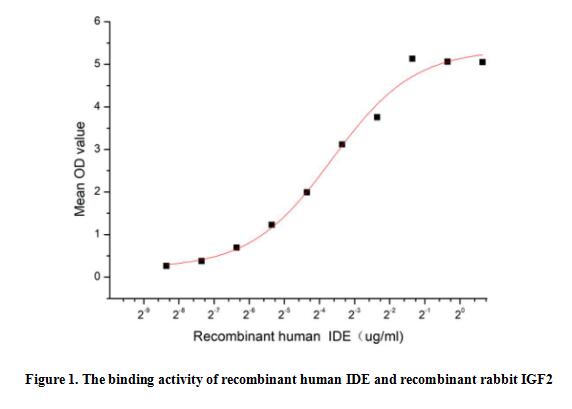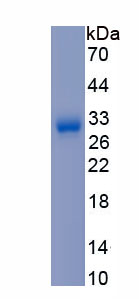Active Insulin Degrading Enzyme (IDE)
Insulysin; Insulin Protease; Abeta-degrading protease; Insulinase
- Product No.APB897Hu01
- Organism SpeciesHomo sapiens (Human) Same name, Different species.
- Buffer Formulation20mM Tris, 150mM NaCl, pH8.0, containing 1mM EDTA, 1mM DTT, 0.01% SKL, 5% Trehalose and Proclin300.
- Traits Freeze-dried powder
- Purity> 90%
- Isoelectric Point7.2
- ApplicationsCell culture; Activity Assays.
- DownloadInstruction Manual
- UOM 10µg50µg 200µg 1mg 5mg
- FOB
US$ 234
US$ 586
US$ 1172
US$ 3516
US$ 8790
For more details, please contact local distributors!
ACTIVITY TEST

Insulin Degrading Enzyme (IDE) is an evolutionarily conserved 110-kDa zinc metalloprotease. It has been described principally as a cytosolic enzyme but is also found in multiple cellular compartments including endosomes, peroxisomes, mitochondria, the cell surface and in secreted form. IDE is a major enzyme responsible for insulin degradation. In addition to insulin, IDE degrades many targets including glucagon, atrial natriuretic peptide, and beta-amyloid peptide, regulates proteasomal degradation and other cell functions. In addition, IDE can degrade IGF2, thus affecting the concentration and activity of IGF2 in the cell. Thus a functional binding ELISA assay was conducted to detect the interaction of recombinant human IDE and recombinant rabbit IGF2. Briefly, IDE was diluted serially in PBS with 0.01% BSA (pH 7.4). Duplicate samples of 100 μl were then transferred to IGF2-coated microtiter wells and incubated for 1h at 37℃. Wells were washed with PBST and incubated for 1h with anti-IDE pAb, then aspirated and washed 3 times. After incubation with HRP labelled secondary antibody for 1h at 37℃, wells were aspirated and washed 5 times. With the addition of substrate solution, wells were incubated 15-25 minutes at 37℃. Finally, add 50 µL stop solution to the wells and read at 450/630 nm immediately. The binding activity of recombinant human IDE and recombinant rabbit IGF2 was shown in Figure 1, the EC50 for this effect is 0.08 ug/mL.
USAGE
Reconstitute in 20mM Tris, 150mM NaCl (pH8.0) to a concentration of 0.1-1.0 mg/mL. Do not vortex.
STORAGE
Avoid repeated freeze/thaw cycles. Store at 2-8°C for one month. Aliquot and store at -80°C for 12 months.
STABILITY
The thermal stability is described by the loss rate. The loss rate was determined by accelerated thermal degradation test, that is, incubate the protein at 37°C for 48h, and no obvious degradation and precipitation were observed. The loss rate is less than 5% within the expiration date under appropriate storage condition.
GIVEAWAYS
INCREMENT SERVICES
-
 BCA Protein Quantification Kit
BCA Protein Quantification Kit
-
 Molecular Mass Marker for Protein
Molecular Mass Marker for Protein
-
 Monoclonal Antibody Customized Service
Monoclonal Antibody Customized Service
-
 Polyclonal Antibody Customized Service
Polyclonal Antibody Customized Service
-
 Protein Activity Test Experiment Service
Protein Activity Test Experiment Service
-
 Electrophoretic Mobility Shift Assay (EMSA) Experiment Service
Electrophoretic Mobility Shift Assay (EMSA) Experiment Service
-
 Buffer
Buffer
-
 Lentivirus Packaging Experiment Service
Lentivirus Packaging Experiment Service
-
 Adenovirus Packaging Experiment Service
Adenovirus Packaging Experiment Service
-
 Real Time PCR Experimental Service
Real Time PCR Experimental Service
-
 Spike RBD Protein (S-RBD)
Spike RBD Protein (S-RBD)
-
 Protein G
Protein G
-
 Protein A
Protein A
| Magazine | Citations |
| J Neurochem | Reduction PubMed: 26442993 |
| African Journal of Pharmacy and Pharmacology | Peptide hydroxamate derivatives as regulators for insulin receptor signaling and its degradation by zinc metalloprotease in diabetic rats article-full-text-pdf |
| Biomedicine & Pharmacotherapy | Vitamin D3 intake as regulator of insulin degrading enzyme and insulin receptor phosphorylationin diabetic rats. pubmed:27930980 |
| Biological Trace Element Research | Nigella sativa Oil and Chromium Picolinate Ameliorate Fructose-Induced Hyperinsulinemia by Enhancing Insulin Signaling and Suppressing Insulin-Degrading Enzyme in Male Rats 10.1007/s12011-017-1167-z |
| Neuroscience | The Protective Effects of IGF-I against β-Amyloid-related Downregulation of Hippocampal Somatostatinergic System Involve Activation of Akt and Protein Kinase A Pubmed:29406271 |
| Catalog No. | Related products for research use of Homo sapiens (Human) Organism species | Applications (RESEARCH USE ONLY!) |
| RPB897Hu01 | Recombinant Insulin Degrading Enzyme (IDE) | Positive Control; Immunogen; SDS-PAGE; WB. |
| APB897Hu01 | Active Insulin Degrading Enzyme (IDE) | Cell culture; Activity Assays. |
| PAB897Hu01 | Polyclonal Antibody to Insulin Degrading Enzyme (IDE) | WB; IHC |
| MAB897Hu21 | Monoclonal Antibody to Insulin Degrading Enzyme (IDE) | WB |
| MAB897Hu22 | Monoclonal Antibody to Insulin Degrading Enzyme (IDE) | WB |
| SEB897Hu | ELISA Kit for Insulin Degrading Enzyme (IDE) | Enzyme-linked immunosorbent assay for Antigen Detection. |
| LMB897Hu | Multiplex Assay Kit for Insulin Degrading Enzyme (IDE) ,etc. by FLIA (Flow Luminescence Immunoassay) | FLIA Kit for Antigen Detection. |
| KSB897Hu01 | ELISA Kit DIY Materials for Insulin Degrading Enzyme (IDE) | Main materials for "Do It(ELISA Kit) Yourself" |







